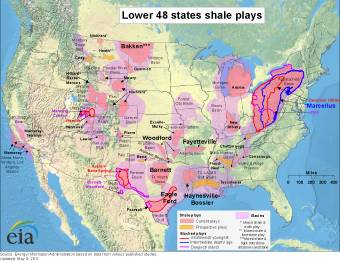You’ve Got Shale: The “Where” and “What” of Shale Gas Formations
Geologically, gas shales are fine grained, organic-rich, sedimentary rock formations that trap natural gas. Gas shale rock has characteristically small pores that are relatively impermeable to natural gas flow unless they are naturally or artificially fractured to create channels connecting the pores. Shale rock is considered so impermeable that geologists sometimes say it makes marble feel “spongy” in comparison.
Shale gas is present across much of North America in basins of both extreme and moderate size. As of 2010, there are at least 22 major shale plays in the U.S., spread diversely over more than 20 states.
 |
| Source: EIA-2011 |
Geologists have known of the presence of natural gas in shale rock for years, but until recently, could not cost-effectively extract it. Two factors came together in recent years to make shale gas production economically viable: (1) advances in horizontal drilling; and (2) advances in hydraulic fracturing. Together, these factors have transformed shale formations from marginal sources of natural gas to substantial contributors to the natural gas supply portfolio, ushering in a robust resurgence in domestic natural gas production.
With the onset of shale gas development, production has been diversified across the country, bringing supply closer to areas where it is consumed. New reserves are discovered so frequently that industry and government authorities have trouble keeping maps up to date. Some of the major shale reserves include:
Marcellus (Pennsylvania, New York, Ohio, West Virginia, Kentucky)
Bakken (North Dakota, Wyoming)
Haynesville (Texas, Loiusiana)
Barnett (Texas)
Eagleford (Texas)
Fayettevile (Arkansas)
Antrim (Michigan, Illinois, Ohio)
Woodford (Oklahoma)
As a result, supply is less susceptible to weather disruptions in the Gulf of Mexico. The geographic diversity of U.S. shale gas resources and advances in technology help ensure a stable and deliverable natural gas supply.